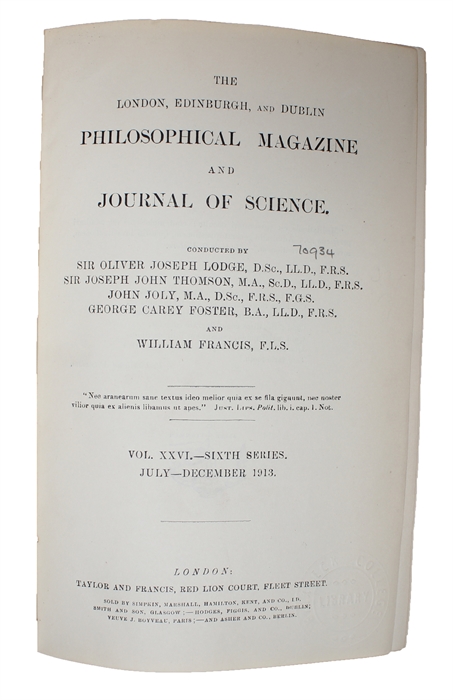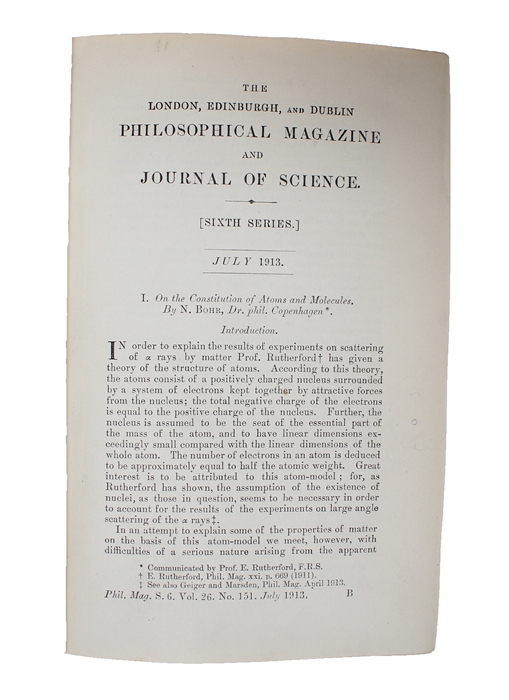THE BIRTH OF MODERN ATOMIC THEORY (PMM 411)
BOHR, NIELS (+) HENRY MOSELEY.
On the Constitution of Atoms and Molecules. 3 Parts (all). (+) The High-Frequency Spectra of the Elements.
London, Taylor & Francis, 1913. 8vo. Bound in one nice contemporary half calf binding with gilt leather title-label to spine. Published in "The London, Edinburgh, and Dublin Philosophical Magazine and Journal of Science", Vol. 26. No. 151-156 offered. Small repair to spine and blind stamped to lower part of title page. Front hindge a bit loose. A fine copy. The Bohr papers: pp. 1-25; pp. 476-502; pp. 857-875. [Moseley:] Pp. 1024-1034. [Entire volume: VIII, 1064 pp.+ 24 plates].
First edition of Bohr's seminal main work, which constitutes the departure from classical theories to the birth of modern atomic physics; by incorporating Planck's quantum postulate it became possible to calculate the wavelength of the hydrogen emission and thus to explain the regularity of the Balmer-lines. In 1922 Bohr was awarded the Nobel Prize "for his services in the investigation of the structure of atoms and of the radiation emanating from them".
"Bohr's three-part paper postulated the existence of stationary states of an atomic system whose behavior could be described using classical mechanics, while the transition of the system from one stationary state to another would represent a non-classical process accompanied by emission or absorption of one quantum of homogeneous radiation, the frequency of which was related to its energy by Planck's equation" (Norman).
In his previous paper ("On the Theory of Decrease of Velocity of Moving Electrified Particles on passing through Matter") Bohr had adopted Rutherford's nuclear model of the atom, and had become convinced that it was the peripherical electrons that determined the chemical properties of an element, whereas the nucleus determine the radioactive properties. However, Rutherford's model had an apparent explanatory problem: Why were the negatively charged electrons held away from the positive nucleus?
In his doctorial dissertation on the electron theory of metals, Bohr had clarified the limitations of this theory, in particular its ability to explain magnetic properties, and he had shown how this arose from the classical nature of some of its foundations. Bohr strongly expected that the key to solving this problem was to be found in some way of introducing Planck's law of quantum action.
In the beginning of 1913 Bohr heard about Rydberg's remarkable discovery in spectroscopy. Rydberg's formula could represent the frequencies of the lines of the hydrogen spectrum in the simplest form in terms of two integers. As soon as Bohr saw this formula, he immediately recognized that it gave him the missing clue to the correct way to introduce Planck's law of quantum of action into the description of the atomic systems.
The rest of the academic year was spent reconstructing the whole theory upon the new foundation and expounding it in a large treatise, which was immediately published as these three papers in the 'Philosophical Magazine'. It was in these papers that Bohr first gave his postulates of the orbital structure of the electrons and their quantized radiation.
Bohr's atomic theory inaugurated two of the most adventurous decades in the history of science. Bohr introduced the following postulates: 1. An electron can revolve about its nucleus only in certain special circular orbits. 2. The ordinary electron revolves about its nucleus in an invariable orbit, without radiating or absorbing energy. 3. Radiation takes place when and only when the electron falls from an orbit with greater energy to one of less energy.
"In his great papers of 1913, Bohr presented his theory as being founded upon two postulates, whose formulation he refined in later papers. The first postulate enunciates the existence of stationary states of an atomic system, the behavior of which may be described in terms of classical mechanics; the second postulate states that the transition of the system from one stationary state to another is a nonclassical process, accompanied by the emission or absorption of one quantum of homogeneous radiation, whose frequency is connected with its energy by Planck's equation. As for the principle by which the possible stationary states are selected, Bohr was still very far from a general formulation; indeed, he was keenly aware of the necessity of extending the investigation to configurations other than the simple ones to which he had restricted himself. The search for sufficiently general quantum conditions defining the stationary states of atomic systems was going to be a major problem in the following period of development of the theory." (DSB).
Also contained in the volume is Henry Moseley's famous paper "The High-Frequency Spectra of the Elements" in which he "used the method of X-ray spectroscopy devised by Braggs to calculate variations in the wave length of the rays emitted by each element. These he was able to arrange in a series according to the nuclear charge of each element. [...] It was now possible to base the periodic table on a firm foundation, and to state with confidence that the number of elements up to uranium is limited to 92." (PMM 407).
PMM 411
Rosenfeld, Bohr Bibliography No. 6.
Order-nr.: 51728



